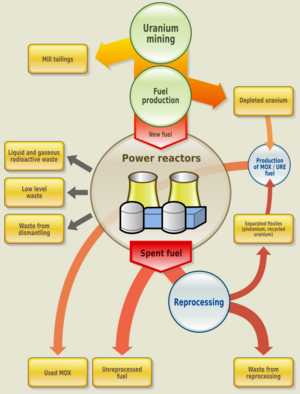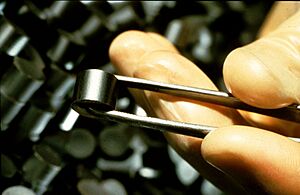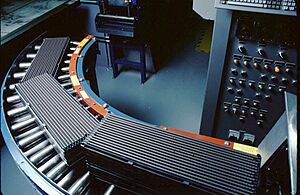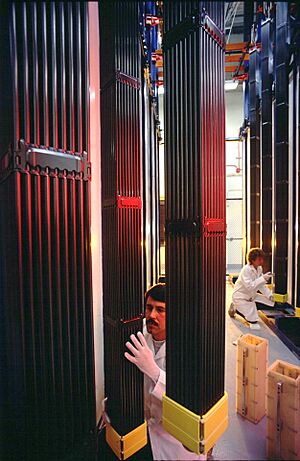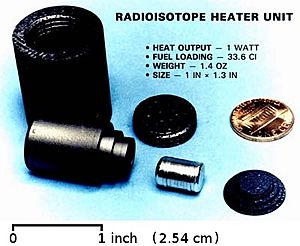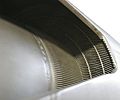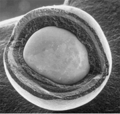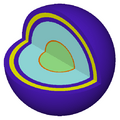Nuclear fuel facts for kids
Nuclear fuel is a special material that helps us create a lot of energy. Think of it like the gasoline for a car, but instead of burning, it uses tiny parts of atoms to make power. This energy is called nuclear energy.
Nuclear fuels are the most powerful energy sources we know! They hold much more energy than regular fuels like wood or coal.
Most nuclear fuels contain heavy elements that can split apart. This splitting process is called nuclear fission. When these elements split inside a nuclear reactor, they release a huge amount of energy. The most common nuclear fuels are uranium and plutonium. While many nuclear fuels are used in reactors, some are used for other things too.
Contents
What is Nuclear Fuel?
Nuclear fuel is any material that can be "consumed" to produce nuclear energy. This is similar to how chemical fuel (like wood or gas) is burned to create energy. However, nuclear fuel does not burn in the same way. Instead, its atoms are split or joined together to release energy.
How Nuclear Fuel Works
The main way nuclear fuel creates energy is through a process called nuclear fission. In fission, the nucleus (center) of a heavy atom is split into two or more smaller nuclei. When this happens, it releases a lot of energy, along with some neutrons. These neutrons can then hit other atoms, causing them to split too. This creates a chain reaction that produces continuous energy.
Fissile Elements
The elements used in nuclear fuel are called fissile elements. This means their atoms can be easily split by neutrons. The two most common fissile elements used in nuclear reactors are uranium and plutonium.
- Uranium: The most widely used nuclear fuel is a type of uranium called uranium-235. It is found naturally in the Earth, but only a small part of natural uranium is uranium-235.
- Plutonium: Plutonium is often created inside nuclear reactors when uranium atoms absorb neutrons. Plutonium-239 is a very important fissile material.
Where Does Nuclear Fuel Come From?
Nuclear fuel, especially uranium, is mined from the Earth. After it's mined, it goes through several steps to become usable fuel. This includes processing it into a form that can be used safely and efficiently in a reactor.
Fuel Pellets and Rods
Most nuclear fuel is shaped into small, solid cylinders called fuel pellets. These pellets are usually made of uranium dioxide. They are very small, often less than an inch long.
These pellets are then stacked inside long, thin metal tubes called fuel rods. Many fuel rods are bundled together to form a fuel assembly. These assemblies are then placed into the core of a nuclear reactor.
Uses of Nuclear Fuel
The main use of nuclear fuel is to generate electricity in nuclear power plants. The heat produced by nuclear fission boils water, creating steam. This steam then turns large turbines, which power generators to make electricity.
Other Uses of Nuclear Fuel
Besides power plants, nuclear fuel has other important uses:
- Research Reactors: Smaller reactors use nuclear fuel for scientific research, to create special materials, or to produce medical isotopes.
- Space Exploration: Tiny amounts of nuclear fuel are used in devices called radioisotope thermoelectric generators (RTGs). These devices provide long-lasting power for spacecraft, especially those exploring the outer solar system where sunlight is too weak for solar panels.
- Naval Propulsion: Nuclear fuel powers submarines and aircraft carriers, allowing them to operate for very long periods without needing to refuel.
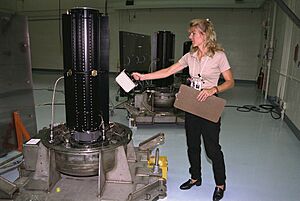
Safety and Waste
Working with nuclear fuel requires strict safety measures because it is radioactive. Nuclear power plants are designed with many safety features to prevent accidents.
After nuclear fuel has been used in a reactor, it becomes "spent fuel." This spent fuel is still radioactive and needs to be stored safely for a very long time. Scientists are always working on new ways to manage and dispose of this waste.
Images for kids
-
A sample of uranium ore.
-
ATR Core The Advanced Test Reactor at Idaho National Laboratory uses plate-type fuel in a clover leaf arrangement. The blue glow around the core is known as Cherenkov radiation.
-
PWR fuel assembly (also known as a fuel bundle) This fuel assembly is from a pressurized water reactor of the nuclear-powered passenger and cargo ship NS Savannah. Designed and built by the Babcock & Wilcox Company.
See also
 In Spanish: Combustible nuclear para niños
In Spanish: Combustible nuclear para niños


